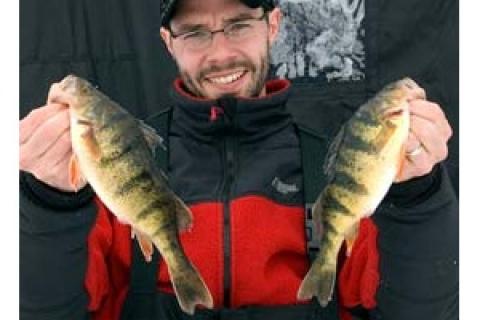
Few species rile up ice anglers like yellow perch. When the bite's hot, these schooling fish can deliver days of non-stop action. Yet, nothing's guaranteed when looking for perch, and their roaming tendencies can challenge even experienced anglers. To help you crack the perch code this winter, heed the following ice fishing tips on winter locations and top baits.
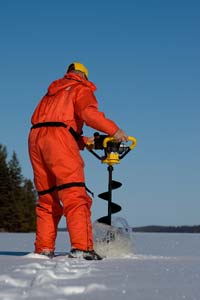
plenty of ice holes to find them.
Winter Locations to Fish Perch
At first ice, look for perch near or in areas still holding healthy weeds in lakes. Bays, slow-tapering drop offs near weed lines, soft-bottom zones, flats, or reefs are all good areas. In rivers, look for perch in similar areas but out of the main river current.
However, not all the perch in a water system do the same thing. For example, one school of perch may be on deep, soft-bottom flats feeding on burrowing aquatic insects, while another school cruises a weedy bay chasing minnows.
In mid-winter smaller fish may hold in the shallows, but expect jumbos to be in deeper water. Focus your search on structures like bars, flats and points for mid-winter perch. Be prepared to cover a lot of ground to find these fish. In rivers, explore deeper areas out of the main river current, such as holes in backwater zones, bays or off-channel areas.
Perch spawn in spring, so as the ice season winds down, you'll find them migrating to the shallows. Prime areas are bays, bars and points near lake inflows and outflows. Tributaries are also worth exploring on rivers, but be careful as increased moving water in spring reduces ice thickness.
Searching for Perch in Cold Weather
If you're keen on catching perch, it's wise to invest in a good pair of boots. Some days you need to do a lot of exploring to locate them. Also add a quality ice auger to your list and a portable ice shelter or sled to carry all your gear.
Ice fishing electronics will also help your search. A portable sonar, such as Humminbird's Portable Flasher line, is critical. Sonar tells you water depth and if fish are in the area. Interpreting the bottom signal also helps you deduce whether you're over a hard or soft bottom area. Perch often prefer the latter, especially if tiny bloodworms are their main food source. Underwater cameras, like those offered by Aqua-Vu, allow you to see if perch are in the area, their size and their direction if moving.
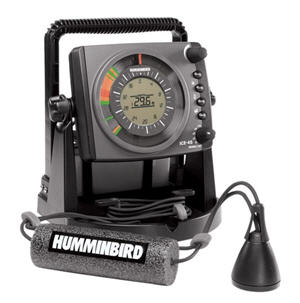
A handheld GPS unit like the Garmin GPSMAP 64s is another useful tool. Use it to mark structures where you've found perch (such as flats, reefs or bays) as well as other important features, like lake access points. Extra data, such as back road maps and underwater lake contours make these units even more powerful.
Categories of Perch Baits to Use
I like to think of my fishing lures as fitting into a few categories. The first are search baits. I use these lures when quickly fishing several holes to try and determine the whereabouts of roaming perch schools. For the most part, I prefer to fish with spoons when searching. Spoons are relatively big jigging baits that put out plenty of flash and vibrations. The following are some good choices:

- Northland's Buckshot Spoon and Forage Minnow Spoons
- Blue Fox's Rattle Flash Jig'n Spoons
- Bay de Noc's Swedish Pimples
- Lindy's Rattl'n Flyer
When trying to attract perch, I start fishing spoons a little less than half way down.

I'll aggressively jig to try and call in fish and keep a diligent eye on my sonar for fish signals. If this doesn't yield results, I'll lower the spoon to the bottom. I intentionally bang the bait on bottom a few times to kick up a
silt cloud. This disturbance mimics bottom-feeding perch and can attract others from a considerable distance. I'll then lift the bait above the cloud and jig. If this doesn't produce any fish after a few minutes I'll move to another hole and repeat the sequence. It can take several moves and dozens of holes before you locate perch, but once you do it's often easy to get them to bite if you're prepared.
More Jigging Baits

The spoons listed above work well to get active perch to bite. Other good lures include hard fishing baits, such as Rapala's Jigging Shad Rap or Rapala's Jgging Rap. Work these baits on a lift-fall-hold sequence and be sure to give the bait plenty of time to glide downward and then come to rest. Perch often hit the bait once it's still, so be ready for the strike. Adding subtle jiggles and small hops can trigger hits.
Soft baits are another good option for perch. Small one- to two-inch tubes are one of my go-to lures for perch. Use tube jig heads between 1/32- to 1/8-ounce depending on the depth of water you're in. Like many species, perch are susceptible to the spiralling decent of tube jigs.
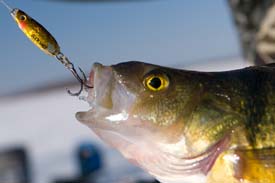
provide flash and plenty of vibrations to
attract perch from a distance.
Finesse Baits for Perch
In some respects, tubes scratch the surface of this category of baits. Some days perch are fussy. Downsizing and using subtle jigging moves is often the secret to catching fish. The top finesse baits for perch are ice fishing jigs, and it's tough to beat maggots as tipping bait.
To work ice jigs, slowly lower the bait towards bottom. Be sure to work the bait down the water column using small hops and pauses to make it dance like a tiny aquatic morsel. When you spot a fish signal on your sonar, drop your jig and stop it just above the fish. Commence the seductive dance by hopping and pausing the bait.
Once a perch is interested (as per a strong signal on your sonar) keep up the jigging sequence that intrigued it. While you're doing this slowly raise the rod or reel in a small amount of line. The objective here is to get the fish to follow the bait. If you can get them to rise with the bait. It might take a few different jigging sequences, but for the most part a chasing fish will eventually strike.
Perch Ice Fishing Rods & Line Recommendations
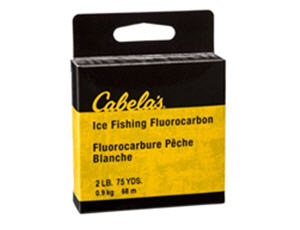
Medium-light powered ice fishing rods work well for perch. If you're after jumbos, though, be sure to carry at least one medium-power stick. Opt for rods featuring ultra-fast and fast actions. They feature sensitive tips to signal strikes, but have plenty of backbone to set the hook and handle fat jumbos. When perch fishing, I usually carry four rods in a range of these powers between 24 and 28 inches.
When it comes to fishing line, perch aren't usually as shy as other panfish such as crappie and bluegills. For the most part, I use line between 3- to 4-pound test. On one of the medium-power combos I have six-pound test. I use it when targeting jumbos near points, drops and other areas where I may intercept the occasional walleye. There are several ice fishing lines available. In recent years, I've switched to fluorocarbon ice fishing lines. They're extremely sensitive and less apt to develop pronounced spool memory coils like some monofilament lines.
Perch are one of winter's best sport fish. Be sure to keep moving until you find them, employing aggressive jigging tactics at first to get active fish to bite. If this doesn't work, switch to a finesse approach to coax hits. Remember, if you can't get one school to go, odds are you can find another group that are hungry.
- 83467 views

